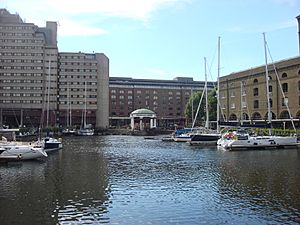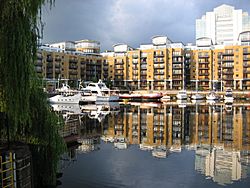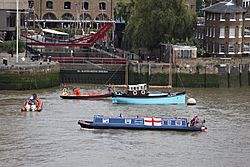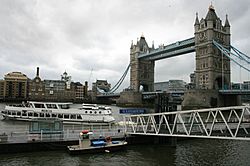St Katharine Docks facts for kids
Quick facts for kids St Katharine Docks |
|
|---|---|
 St Katharine Docks, London |
|
| London borough | |
| Ceremonial county | Greater London |
| Region | |
| Country | England |
| Sovereign state | United Kingdom |
| Post town | LONDON |
| Postcode district | EC3 |
| Dialling code | 020 |
| Police | Metropolitan |
| Fire | London |
| Ambulance | London |
| EU Parliament | London |
| London Assembly | |
St Katharine Docks is a former dock and now a mixed-used district in Central London, in the London Borough of Tower Hamlets and within the East End. It lies on the north bank of the River Thames, immediately downstream of the Tower of London and Tower Bridge. From 1828 to 1968, it was one of the commercial docks that made up the Port of London. It is in the redevelopment zone known as Docklands and is now a popular housing and leisure complex.
History
St Katharine Docks took their name from the former hospital of St Katharine's by the Tower, built in the 12th century, which stood on the site. An intensely built-up 23-acre (9.5 hectares) site was earmarked for redevelopment by an Act of Parliament in 1825, with construction commencing in May 1827. Some 1250 houses were demolished, together with the medieval hospital of St. Katharine. Around 11,300 inhabitants, mostly port workers crammed into unsanitary slums, lost their homes; only the property owners received compensation. The scheme was designed by engineer Thomas Telford and was his only major project in London. George Turnbull and James Waylen were working for Telford. To create as much quayside as possible, the docks were designed in the form of two linked basins (East and West), both accessed via an entrance lock from the Thames. Steam engines designed by James Watt and Matthew Boulton kept the water level in the basins about four feet above that of the tidal river. By 1830, the docks had cost over £2 million to build.
Telford aimed to minimise the amount of quayside activity and specified that the docks' warehouses (designed by the architect Philip Hardwick) be built right on the quayside so that goods could be unloaded directly into them.
The docks were officially opened on 25 October 1828. Although well used, they were not a great commercial success and were unable to accommodate large ships. They were amalgamated in 1864 with the neighbouring London Docks. In 1909, the Port of London Authority took over the management of almost all of the Thames docks, including St Katharine Dock.
The St Katharine Docks were badly damaged by German bombing during the Second World War. All the warehouses around the eastern basin were destroyed, and the site they had occupied remained derelict until the 1990s.
The docks today
The area now features offices, public and private housing, a large hotel, shops and restaurants, a pub (The Dickens Inn, a former brewery dating back to the 18th century), a yachting marina and other recreational facilities. It remains a popular leisure destination.
The east dock is now dominated by the City Quay residential development, comprising more than 200 privately owned flats overlooking the marina. The south side of the east dock is surrounded by the South Quay Estate which was originally social housing. The dock is still used by small to medium-sized boats on a daily basis.
The anchor from the wreck of the Dutch East Indiaman Amsterdam is on display at the entrance to the east dock.
Notable boats
Notable boats regularly moored in the docks include:
- Gloriana, royal barge
- MV Havengore, former Port of London Authority hydrographic survey vessel
Several Thames sailing barges are also based in the docks.
St Katharine Pier
St. Katharine Pier is close to the St Katharine Dock, providing river transport services managed by London River Services. The main service from St Katharine Pier is a circular river cruise operated by Crown River Cruises which goes non-stop to Westminster Millennium Pier before returning via the South Bank arts centre, as well as a Westminster-Greenwich express service run by Thames River Services.
The nearby Tower Millennium Pier, located on the other side of Tower Bridge, now provides the main commuter river boat services to Canary Wharf and Greenwich in the east and the West End in the west, and a fast visitor service to the London Eye.








